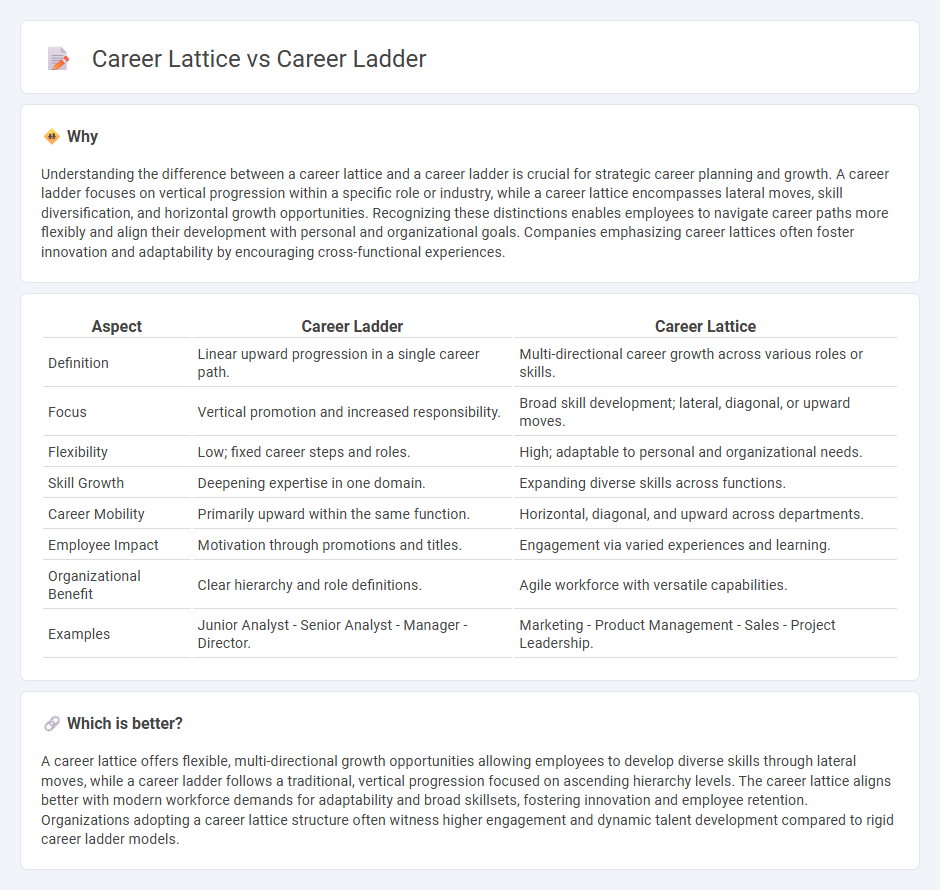
A career lattice offers a flexible approach to professional growth, allowing employees to move laterally, diagonally, and upward within an organization to build diverse skills. In contrast, a traditional career ladder emphasizes vertical progression with clearly defined steps toward higher positions. Explore the key differences between career lattice and career ladder models to optimize your employment strategy.
Why it is important
Understanding the difference between a career lattice and a career ladder is crucial for strategic career planning and growth. A career ladder focuses on vertical progression within a specific role or industry, while a career lattice encompasses lateral moves, skill diversification, and horizontal growth opportunities. Recognizing these distinctions enables employees to navigate career paths more flexibly and align their development with personal and organizational goals. Companies emphasizing career lattices often foster innovation and adaptability by encouraging cross-functional experiences.
Comparison Table
| Aspect | Career Ladder | Career Lattice |
|---|---|---|
| Definition | Linear upward progression in a single career path. | Multi-directional career growth across various roles or skills. |
| Focus | Vertical promotion and increased responsibility. | Broad skill development; lateral, diagonal, or upward moves. |
| Flexibility | Low; fixed career steps and roles. | High; adaptable to personal and organizational needs. |
| Skill Growth | Deepening expertise in one domain. | Expanding diverse skills across functions. |
| Career Mobility | Primarily upward within the same function. | Horizontal, diagonal, and upward across departments. |
| Employee Impact | Motivation through promotions and titles. | Engagement via varied experiences and learning. |
| Organizational Benefit | Clear hierarchy and role definitions. | Agile workforce with versatile capabilities. |
| Examples | Junior Analyst - Senior Analyst - Manager - Director. | Marketing - Product Management - Sales - Project Leadership. |
Which is better?
A career lattice offers flexible, multi-directional growth opportunities allowing employees to develop diverse skills through lateral moves, while a career ladder follows a traditional, vertical progression focused on ascending hierarchy levels. The career lattice aligns better with modern workforce demands for adaptability and broad skillsets, fostering innovation and employee retention. Organizations adopting a career lattice structure often witness higher engagement and dynamic talent development compared to rigid career ladder models.
Connection
Career lattice and career ladder are interconnected frameworks that guide professional growth within organizations. The career ladder emphasizes vertical progression through defined job levels, while the career lattice incorporates both vertical and lateral moves to enhance skills and experience. Together, they provide a comprehensive approach to career development by offering employees multiple pathways for advancement and diversification.
Key Terms
Vertical advancement (Career Ladder)
Career ladder emphasizes vertical advancement where employees move up through a hierarchy by gaining expertise, skills, and responsibilities in a specific role or function. This model focuses on promotions to higher positions, reflecting increased authority and compensation within a clearly defined pathway. Explore the benefits and limitations of vertical career progression to determine the best growth strategy for your professional development.
Lateral movement (Career Lattice)
The career lattice emphasizes lateral movement, allowing professionals to gain diverse skills and broaden their expertise across different roles or departments. Unlike the traditional career ladder, which focuses primarily on upward promotions, the lattice model supports flexibility and cross-functional growth, fostering adaptability in rapidly changing industries. Explore how a career lattice can enhance your career development and provide opportunities for continuous learning.
Skill diversification
Career ladder emphasizes vertical progression in a specific role or industry, highlighting skill depth and mastery. Career lattice promotes skill diversification by encouraging lateral and diagonal moves across different functions, fostering a multifaceted skill set. Explore how career lattice models can expand your expertise and adaptability in today's dynamic job market.
Source and External Links
What is Career Ladder? - Growthspace - A career ladder is a planned path for upward advancement within a company, guiding employee development through increasing responsibilities and rewards, from entry level to senior executive roles.
Career ladder - Wikipedia - The career ladder metaphor describes job progression through higher pay, skills, responsibilities, or authority, typically representing a singular track of upward promotion without lateral movement.
The Keys To Effective Job Ladders (With Helpful Example) - Indeed - Effective job ladders are created by defining clear job descriptions, consulting upper-level staff, dividing roles into tiers, and identifying key skills and educational needs for advancement.
 dowidth.com
dowidth.com